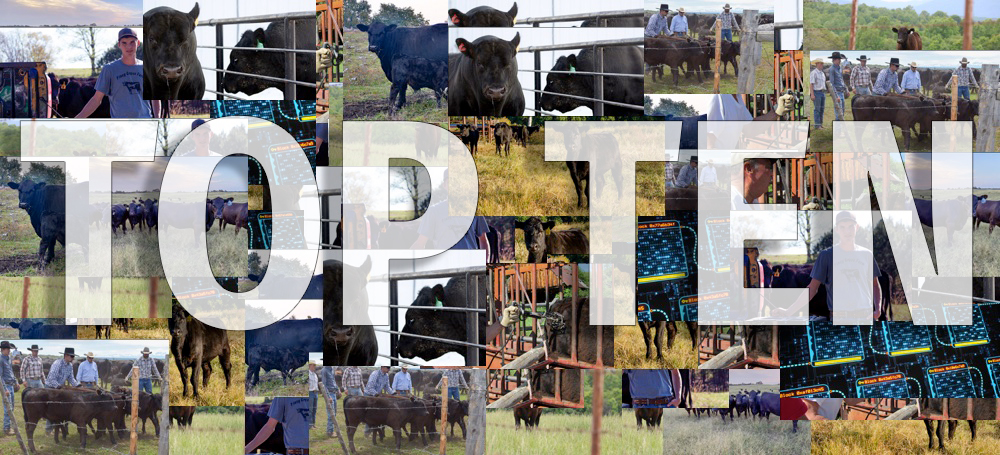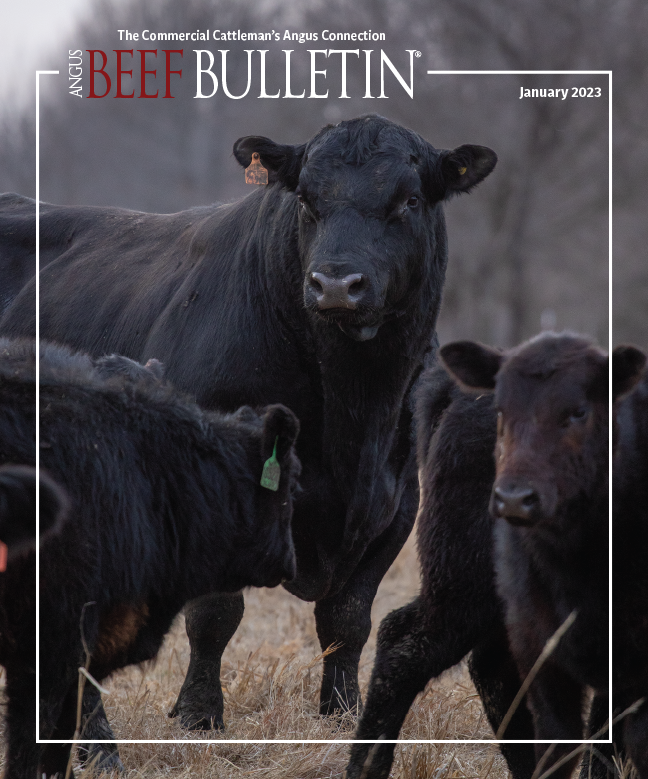
2022’s Top 10
A recap of the top 10 Angus Beef Bulletin EXTRA articles in 2022.
The Angus Beef Bulletin strives to provide those of you purchasing registered Angus bulls and their calves the information you need to make the most of your investment in Angus genetics. To supplement the five mailed issues and annual Feeder-Calf Marketing Guide, the Angus Beef Bulletin EXTRA provides management, health, nutrition, marketing and industry articles pertinent to your bottom line on a biweekly schedule. Here’s a recap of the top 10 articles from 2022.
1. Don’t Buy a Fat Bull
Sale-season nutrition should prepare bull for work instead of beauty.
Traditionally, young bulls offered for sale are often too fat, especially the ones that have gone through maximum-gain performance tests to measure rate of gain and feed efficiency. We now know that this can be detrimental to their fertility and longevity, but many young bulls are still too fat at sale time. John Kastelic, department head and professor of production animal health at the University of Calgary, has done a lot of research on nutrition in bulls.
2. It Costs How Much?
This budget helps ranchers calculate their annual cow costs.
What does it cost to manage a cow on your operation? How do you calculate the costs? How do you value raised feed, labor and equipment, as well as replacement females grown on the ranch? These questions are frequently asked when the conversation of annual cow costs arises.
The one-page budget located at https://bit.ly/EXTRAccbudget estimates annual cow costs in Nebraska and the resulting total to produce a weaned calf under current conditions. It could be a useful tool in your area, as well.
3. A Father’s Faith
Soft feeder-cattle prices and COVID ended up being blessings in disguise for this young cattleman.
In the fall of 2019, 17-year-old Caleb Tyree had a dilemma. When he was 14, he borrowed the money to buy 100 heifers. The last installment was due, but feeder-calf prices were too low to make the final payment from the sale of that year’s preconditioned calves.
“We talked about it and prayed about it,” says his dad, veterinarian David Tyree. “I ended up fronting him the money so he could feed them longer.”
4. Select Heifers that Stay in the Herd
Colorado cattleman offers selection tips for long-lasting females.
The ability to continue in agriculture is crucial to the future of the beef industry and to individual producers. Reducing input costs and increasing profits is essential. It generally costs a lot to buy or to develop replacement heifers, so it is very important to select good ones that will stay in the herd a long time.
There are many factors that influence longevity in females. Adequate nutrition is important, but it’s important to give that nutrition to fertile, efficient heifers.
5. Angus Proud: Scott Sproul
Oklahoma operation learned wisdom of moving calving season to better suit their marketing needs.
The Sproul family tried something new with their calves last year, and it paid dividends. The Oklahoma cow-calf operation shifted its calving season to begin in March so the calves could go on wheat pasture. Co-owner Scott Sproul says it was their first year to sell the calves on Superior Livestock, and that will be their new normal.
The 100% Angus operation has commercial Angus cows bred to registered Angus bulls. The herd at Sproul Family Farms switched to Angus about two decades ago, and Sproul says that was a wise choice.
6. Handy Homemade Wire Unroller
Wire unroller developed for fencing in steep sagebrush-covered mountainsides.
Good fences need to last a long time, so many farms and ranches have barbed-wire fences for big pastures and rangeland. When building barbed-wire fence, it helps to have an easy way to unroll wire. Many methods are used — such as putting the roll on a stationary bar at a brace or corner and pulling the wire along the fenceline. People often put a bar or pole across the end of a pickup, attach the end of the wire to the fence post, and drive along to unroll the wire.
A simpler method was devised by Idaho rancher Lynn Thomas, now 78 years old, a few years ago when he needed to build several miles of fence with limited help and waning strength. Necessity was the mother of his invention.
7. Four Ways to Stay Safe When Working Cattle
Veterinarian gives safety considerations for before and while working cattle.
Large animals and unpredictable situations can certainly lead to accidents. Accidents happen, but it pays to think ahead and avoid putting yourself into a risky situation.
Most cattle herds are gathered and worked for branding, vaccinating, pregnancy testing, weaning and other necessary management tasks. Many cattle are put through the chute twice or more annually. It is important to make sure these cattle-working tasks are accomplished smoothly and safely for the cattle and for the safety of the crew.
8. Life After Death by Suicide
Life continues for those left behind, treat them with care.
“No one ever mentions my dad’s name. I’m sure they are uncomfortable bringing up my dad’s name to me because they don’t want me to be hurt, but I’m already hurting,” shared a grieving family member with Adrienne DeSutter, an advocate for rural mental health, farmer and certified school counselor.
When asked, “How should we respond after a suicide?” Adrienne makes it clear: “Don’t act like they didn’t exist; it is OK to say their name.”
9. Advanced Tech With Real-world Applications
New tech opportunities have been tried and tested.
The Range Beef Cow Symposium, hosted Nov. 16-17, in Rapid City, S.D., gathered several technology companies and university extension specialists to give practical demonstrations on new technologies. Read more to find out how ranchers have been able to apply them.
10. Blockchain Beginning to Change the World — and the Beef Industry
Safer than traditional databases, blockchain is a new form of digital information sharing.
The term “blockchain” is one that is going to be heard — and used — much more in society in the years ahead, according to Steve Lupien with the University of Wyoming. In fact, he predicts blockchain is going to become as ubiquitous — or ever-present — as the internet.
Lupien is director of the Center for Blockchain and Digital Initiatives within the College of Business at the University of Wyoming.

